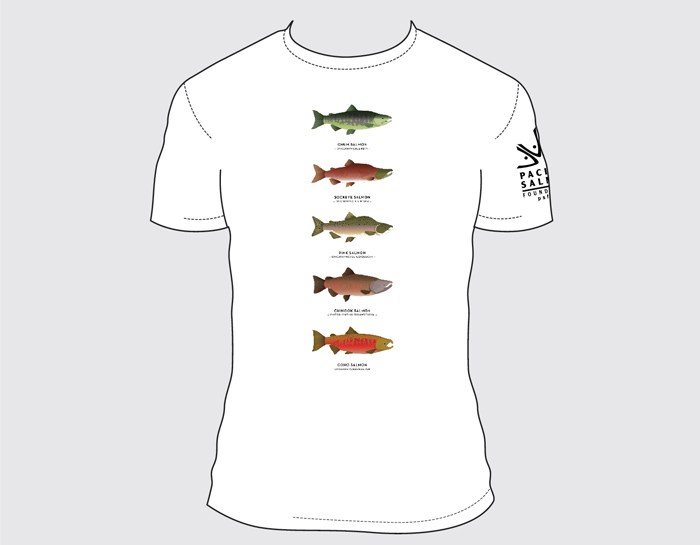You may have heard the news that the Fraser River salmon return this year will be the lowest in recorded history? Definitely not awesome, and something Vancouver's own Pacific Salmon Foundation aren't happy to see; they work to help salmon return to rivers all across our province. They also educate the public about their habitats and why they're so important to protect. We recently launched a campaign where we're trying to raise $10,000 for them by selling t-shirts, posters and prints with the artwork you'll see below.
Below are the 5 images that Bill Watterson illustrated for us, along with some of the key traits of each species. Note that they are represented here in their spawning phase, once they've reached their rivers after a long life in the ocean. The PSF works to make sure more of them make it to this phase in their life, so we can continue to enjoy salmon as a resource in BC for generations to come.
Chum Salmon (Oncorhynchus keta)
Chums can weigh up to 10 kg and spawn in the lower reaches of most coastal streams and rivers. Spawning Chums have a dark horizon- tal stripe running down their sides. Males have canine-like teeth and a checkerboard colouration.
FAST FACT: Abundant and large, Chum salmon are important food sources for people and coastal ecosystems.

Sockeye Salmon (Oncorhynchus nerka)
A medium-sized salmon, ocean-going Sockeye are silver/blue in colour, with small black speckles along the body. As Sockeye approach their home stream, their bodies turn varying shades of red. In most cases, resulting in brilliant scarlet bodies with a bright green head.
FAST FACT: Sockeye salmon are the only species that are bright red when canned.

Pink Salmon (Oncorhynchus gorbuscha)
Pinks are the smallest of the Pacific salmon and weigh up to 3 kg. Pinks feed on zooplankton and krill, which gives the flesh a pink colour. Mature males develop a large humped back. They also have large oval black spots on the back of the body and on both lobes of the tail fin.
FAST FACT: Pinks have the shortest lifespan (just two-years) of the Pacific salmon species.

Chinook Salmon (Oncorhynchus tshawytscha)
These are the largest of the Pacific salmon and usually weigh up to 50 kg. The flesh of adults can range in colour from white to deep red. Chinooks have a dark mouth and black gums at the base of the teeth. They also have a V-shaped, silver tail that can be covered with spots.
FAST FACT: The commercial catch world record is 57 kg caught near Rivers Inlet, B.C. in the late ’70s.

Coho Salmon (Oncorhynchus kisutch)
There are more populations of Coho than any other Pacific salmon species in B.C. While Coho weigh on average around 3.6 kg, they can reach 16 kg. Renowned for their aggressive strikes at prey, they are a favorite for recreational fisheries.
FAST FACT: Found in many small streams, Coho are the most widely distributed of all Pacific salmon.

Buy a t-shirt, poster or print with these designs BEFORE SEPTEMBER 21 at fundrazr.com/SalmonClassrooms. All of the proceeds go towards funding educational programs that will inspire the next generation of salmon stewards, a vital component in making sure salmon will be around in the long run. Learn more in the video below.



